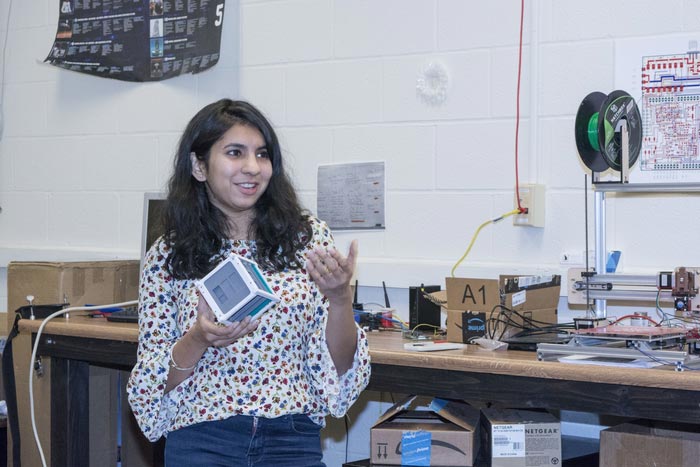New AI navigation prevents crashes

University of Cincinnati engineering graduate Himadri Pandey holds a mockup cube satellite in a UC lab as part of a student club called the UC CubeCats. UC engineers are developing collision-avoidance systems that one day will help autonomous robots service, assemble or manufacture satellites in orbit.
Credit: Lisa Britton/UC Creative
Collision-avoidance system gets us closer to robots that can fix satellites or spacecraft in orbit.
What do you call a broken satellite?
Today, it’s a multimillion-dollar piece of dangerous space junk.
But a new collision-avoidance system developed by students at the University of Cincinnati is getting engineers closer to developing robots that can fix broken satellites or spacecraft in orbit.
UC College of Engineering and Applied Science doctoral students Daegyun Choi and Anirudh Chhabra presented their project at the Science and Technology Forum and Exposition in January in San Diego, California. Hosted by the American Institute of Aeronautics and Astronautics, it’s the world’s largest aerospace engineering conference.
“We have to provide a reliable collision-avoidance algorithm that operates in real time for autonomous systems to perform a mission safely. So we proposed a new collision-avoidance system using explainable artificial intelligence,” Choi said.
He has been working on similar projects at UC for the past two years, publishing three articles in peer-reviewed journals based on Choi’s novel algorithms.
UC researchers tested their system in simulations, first by deploying robots in a two-dimensional space. Their chosen digital battlefield? A virtual supermarket where multiple autonomous robots must safely navigate aisles to help shoppers and employees.
“This scenario presents many of the same obstacles and surprises that an autonomous car sees on the road,” study co-author and UC assistant professor Donghoon Kim said.
“We can see unexpected human behaviors there and learn how well we can actually predict their follow-on motions,” Kim said. “Likewise, we can test how we can operate those robotic platforms autonomously without causing collisions.”
Students built a prototype for design and testing with faculty in UC’s College of Design, Architecture, Art, and Planning and plan to test it under lab conditions.
But the collision-avoidance system works as well in a three-dimensional space for drones or flying cars. UC students demonstrated their three-dimensional project at the SciTech conference.
They plan to apply it to the arguably trickier environment of zero gravity in the frictionless vacuum of space. If an autonomous robot accidentally bumps a satellite that it intends to repair, the collision can send the robot, the satellite or both spinning wildly out of control.
“If you provide a small amount of input, the robot will move forward forever,” Kim said. “The environment is truly different, so control is critical. At the same time, we would like to deploy multiple spacecraft to support a satellite repair mission.”
Engineers envision deploying multiple autonomous robots to work on coordinated tasks such as repair, maintenance or assembly.
“Collision avoidance is fundamental to perform coordinated tasks, but it’s not that simple,” Kim said.
UC’s Department of Aerospace Engineering and Engineering Mechanics is among many academic, government and industry leaders working on this problem known as On-Orbit Servicing, Assembly and Manufacturing. These innovations hold the promise of extending the lifespan of satellites, making critical repairs to telescopes or improving the feasibility of interplanetary exploration.
Satellites represent about one-third of the $371 billion global space economy, according to the industry analyst firm BryceTech.
“This work is one of the hot topics right now,” Kim said. “The first step is avoiding collisions while deploying multiple agents in a designated space.”
UC’s system relies on a type of artificial intelligence called explainable AI. It uses fuzzy logic, a system that relies on degrees of truth rather than a binary right or wrong. The system allows engineers to understand the relationship between inputs and outputs through observed rules.
“Artificial intelligence has been applied in many different places, but not much in aerospace engineering. That’s because aerospace engineering is very conservative,” Kim said.
But Kim said that is likely to change as technology like the collision-avoidance system he and his students are developing becomes more proven.
“Emerging AI is physics-informed rather than relying solely on data,” Kim said. “If we know the physical behavior, we can use that as well as the data so we can get more meaningful information and a reliable AI model.”
Method of Research: Experimental study
Subject of Research: Not applicable
Article Title: Collision Avoidance of Unmanned Aerial Vehicles Using Fuzzy Inference System-Aided Enhanced Potential Field
COI Statement: No conflicts
Media Contact
Michael Miller
University of Cincinnati
michael.miller3@uc.edu
Office: 513-556-6757
All latest news from the category: Information Technology
Here you can find a summary of innovations in the fields of information and data processing and up-to-date developments on IT equipment and hardware.
This area covers topics such as IT services, IT architectures, IT management and telecommunications.
Newest articles

Innovative 3D printed scaffolds offer new hope for bone healing
Researchers at the Institute for Bioengineering of Catalonia have developed novel 3D printed PLA-CaP scaffolds that promote blood vessel formation, ensuring better healing and regeneration of bone tissue. Bone is…

The surprising role of gut infection in Alzheimer’s disease
ASU- and Banner Alzheimer’s Institute-led study implicates link between a common virus and the disease, which travels from the gut to the brain and may be a target for antiviral…

Molecular gardening: New enzymes discovered for protein modification pruning
How deubiquitinases USP53 and USP54 cleave long polyubiquitin chains and how the former is linked to liver disease in children. Deubiquitinases (DUBs) are enzymes used by cells to trim protein…



